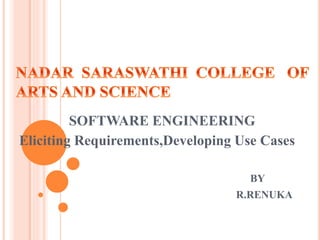
Software engineering
- 1. SOFTWARE ENGINEERING Eliciting Requirements,Developing Use Cases BY R.RENUKA
- 2. ELICITING REQUIREMENTS Eliciting Requirements Eliciting requirement helps the user for collecting the requirement. Eliciting requirement steps are as follows: 1. Collaborative requirements gathering 2. Quality Function Deployment (QFD) QFD consist of three types of requirement: * Normal requirements *Expected requirement *Exciting requirements 3. Usage scenarios 4. Elicitation work product
- 3. 1. Collaborative requirements gathering Gathering the requirements by conducting the meetings between developer and customer. Fix the rules for preparation and participation. The main motive is to identify the problem, give the solutions for the elements, negotiate the different approaches and specify the primary set of solution requirements in an environment which is valuable for achieving goal.
- 4. 2. Quality Function Deployment (QFD) In this technique, translate the customer need into the technical requirement for the software. QFD system designs a software according to the demands of the customer. QFD consist of three types of requirement: Normal requirements: The objective and goal are stated for the system through the meetings with the customer. For the customer satisfaction these requirements should be there.
- 5. Expected requirement These requirements are implicit. These are the basic requirement that not be clearly told by the customer, but also the customer expect that requirement. Exciting requirements These features are beyond the expectation of the customer. The developer adds some additional features or unexpected feature into the software to make the customer more satisfied. For example, the mobile phone with standard features, but the developer adds few additional functionalities like voice searching, multi-touch screen etc. then the customer more exited about that feature.
- 6. 3. Usage scenarios Till the software team does not understand how the features and function are used by the end users it is difficult to move technical activities. To achieve above problem the software team produces a set of structure that identify the usage for the software. This structure is called as 'Use Cases'.
- 7. 4. Elicitation work product The work product created as a result of requirement elicitation that is depending on the size of the system or product to be built. The work product consists of a statement need, feasibility, statement scope for the system. It also consists of a list of users participate in the requirement elicitation.
- 8. DEVELOPING USE CASES What is a use case? • A requirements analysis concept • A case of a use of the system/product • Describes the system's actions from a the point of view of a user • Tells a story • A sequence of events involving • Interactions of a user with the system • Specifies one aspect of the behavior of a system, without specifying the structure of the system • Is oriented toward satisfying a user's goal
- 9. How do we describe use cases? • Textual or tabular descriptions • User stories • Diagrams
- 10. Use Case Descriptions • actors - something with a behavior or role, e.g., a person, another system, organization. • scenario - a specific sequence of actions and interactions between actors and the system, a.k.a. a use case instance • use case - a collection of related success and failure scenarios, describing actors using the system to support a goal
- 11. What is an Actor? • Include all user roles that interact with the system • Include system components only if they responsible for initiating/triggering a use case. • For example, a timer that triggers sending of an e-mail reminder • primary - a user whose goals are fulfilled by the system • importance: define user goals • supporting - provides a service (e.g., info) to the system • importance: clarify external interfaces and protocols • offstage - has an interest in the behavior but is not primary or supporting, e.g., government • importance: ensure all interests (even subtle) are identified and satisfied
- 12. FINDING ACTORS [1] External objects that produce/consume data: • Must serve as sources and destinations for data • Must be external to the system Finding Actors [2] Ask the following questions: • Who are the system’s primary users? • Who requires system support for daily tasks? • Who are the system’s secondary users? • What hardware does the system handle? • Which other (if any) systems interact with the system in question? • Do any entities interacting with the system perform multiple roles as actors? • Which other entities (human or otherwise) might have an interest in the system's output?
- 13. WHAT IS A USER STORY? •An abbreviated description of a use case •Used in agile development Answers 3 questions: 1.Who? 2.Does what? 3.And why? As a , I want so that
- 14. ELEMENTS OF USE CASE DIAGRAM: Actor • Actor is someone interacting with use case (system function). Named by noun. • Similar to the concept of user, but a user can play different roles; (example: a prof. can be instructor and researcher – plays 2 roles with two systems). • Actor triggers use case. • Actor has responsibility toward the system (inputs), and Actor have expectations from the system (outputs).
- 15. ELEMENTS OF USE CASE DIAGRAM: Other details Boundary of system <> Include relationship between Use Cases (one UC must call another; e.g., Login UC includes User Authentication UC) <> Extend relationship between Use Cases (one UC calls Another under certain condition; think of if-then decision points)